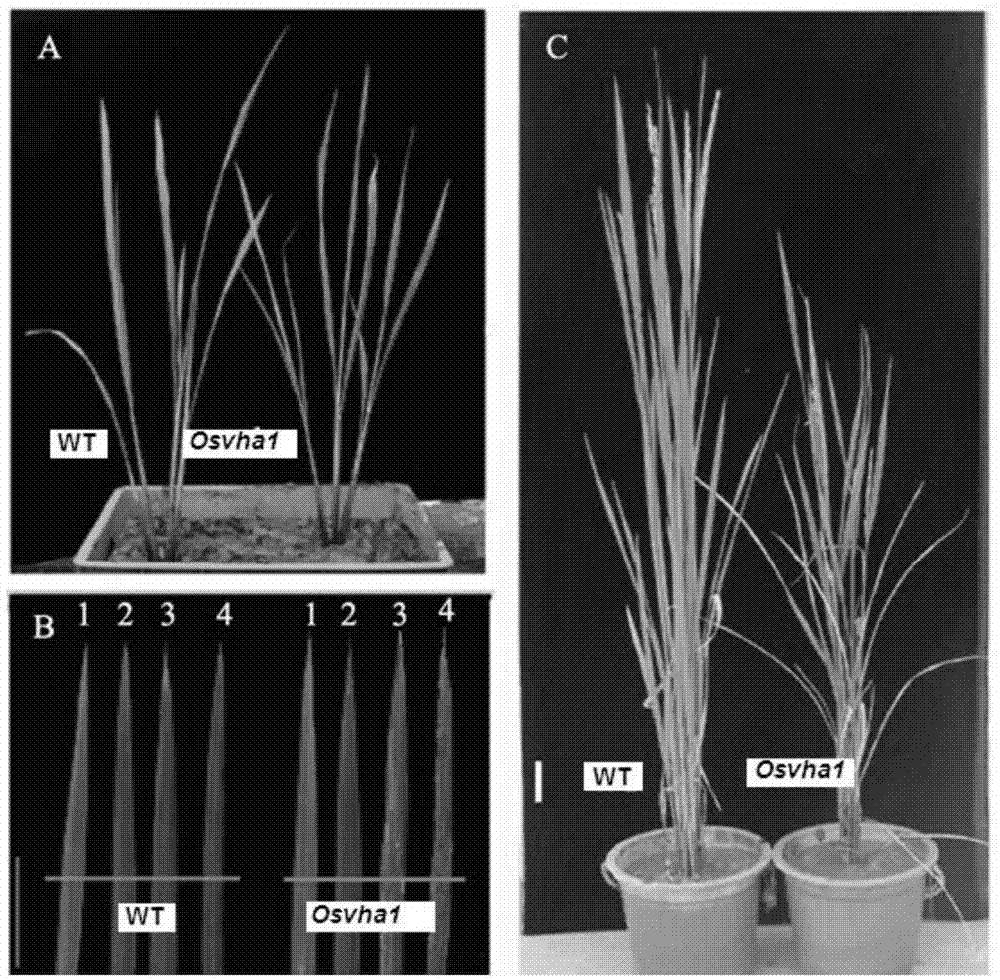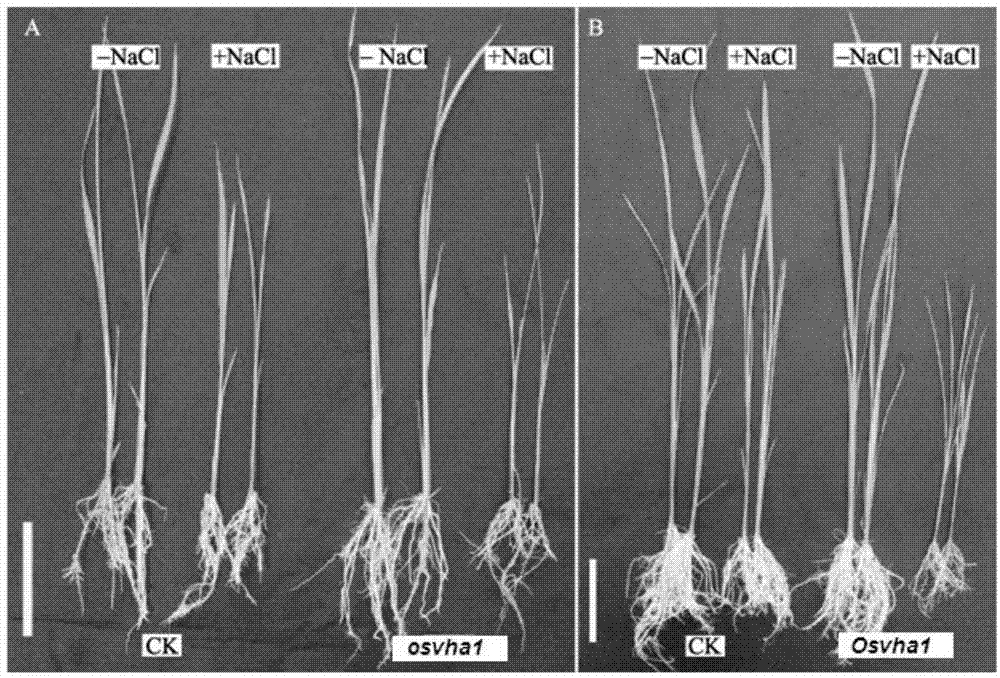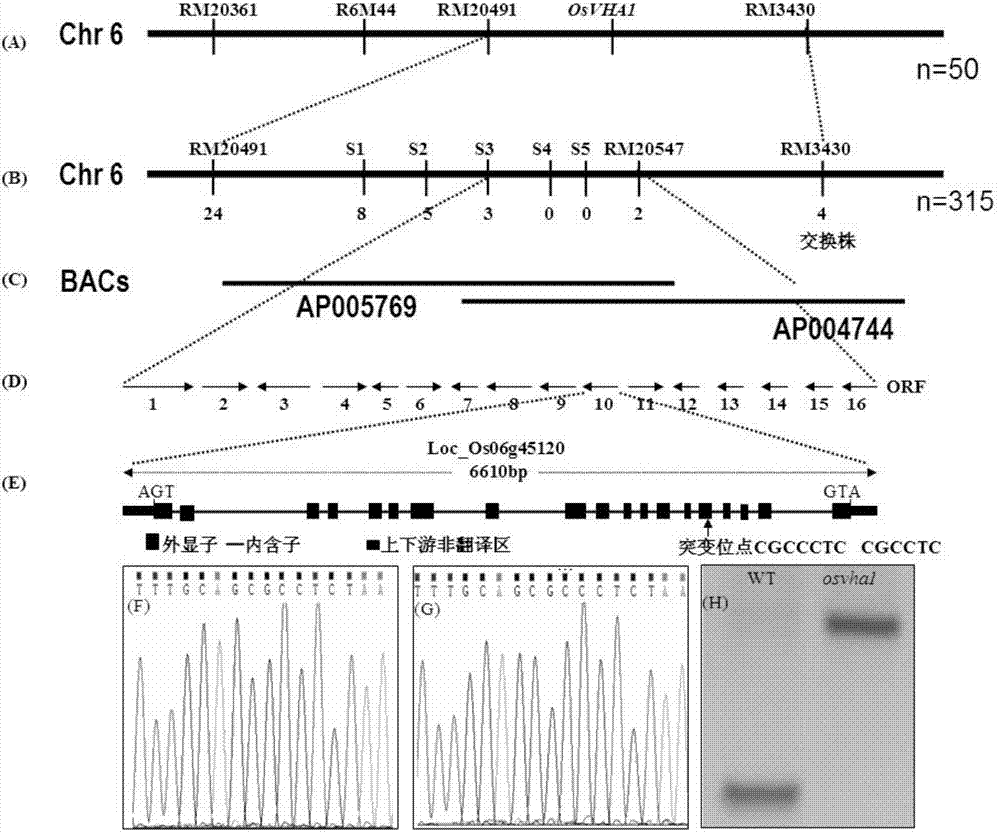Application of rice genes OsVHA1 in delaying senility of plant leaves and improving plant salt tolerance
A plant leaf and gene technology, applied in angiosperms/flowering plants, botanical equipment and methods, applications, etc., can solve the problems of female gametophyte death, more leaf division, and so on, so as to delay the aging of plant leaves, The effect of improving salt tolerance
- Summary
- Abstract
- Description
- Claims
- Application Information
AI Technical Summary
Problems solved by technology
Method used
Image
Examples
Embodiment 1
[0028] Example 1 Isolation and genetic analysis of mutants
[0029] pass 60Co radiation mutagenesis long-lasting high blast resistance material self-selection 1 (from the Rice Research Institute of Enshi Academy of Agricultural Sciences), screened out the premature leaf senescence and salt-sensitive mutant osvha1 from the offspring, and obtained stable mutant traits through multiple generations of backcrossing and selfing strains. The premature senescence trait starts at the tillering stage of osvha1 mutant plants ( figure 1 A and 1B), by the time of heading and flowering stage, all leaves showed different degrees of premature senescence symptoms ( figure 1 C). Using osvha1 as the female parent, the F 1 , F 1 The plants behaved normally; F 1 F obtained by selfing 2 The offspring showed wild type and mutant phenotypes, and the segregation ratio of wild type:mutant=3:1, thus indicating that the senescence traits were controlled by a single recessive gene.
Embodiment 2
[0030] Example 2 Salt Sensitivity Analysis of Mutant osvha1
[0031] at 100mmol L -1 After being treated for 7 days under NaCl stress, the leaves of the osvha1 mutant were curled, and the tips of the leaves were partially dead ( figure 2 A). Simultaneously, plant height and biological yield are compared with embodiment 1 described wild-type control self-selected No. 1 and decline respectively 10.6% and 29.0% ( figure 2 A), while the 7d plant net growth height, root net growth length and net biological yield were respectively 13.7%, 9.9% and 37.5% lower than the control. After returning to growth for 5 days, 12.4% of the mutants withered and died, and the growth rate of the treated mutants was significantly slower than that of the treated wild-type control ( figure 2 B), the mutant plant height and biological yield are respectively 43.5% and 53.8% less than the control, while the net growth height of the 5d plant, the net growth length of the root and the net biological y...
Embodiment 3
[0032] Example 3 Fine mapping of aging gene OsVHA1
[0033] 500 pairs of SSR markers and 50 pairs of InDel markers evenly distributed on 12 chromosomes of rice were selected, and polymorphism screening was performed on the osvha1 mutant and 02428 one by one. The results showed that 178 pairs of primers were polymorphic between the two parents. Sex ratio was 32.4%. Then these 178 pairs of markers were used to conduct BSA analysis on the two constructed gene pools, and it was found that three SSR markers RM20361, RM20491 and RM3430 on the long arm of rice chromosome 6, and one InDel marker R6M44 were in the mutant pool and There is a clear partial separation between normal pools. Subsequently, the 50 F 2 Genotype analysis was performed on individual plants with mutant phenotypes, and the physical arrangement position of the four markers and the OsVHA1 gene on chromosome 6 was determined in combination with the genotype of each molecular marker as RM20361-R6M44-RM20491-OsVHA1-R...
PUM
 Login to View More
Login to View More Abstract
Description
Claims
Application Information
 Login to View More
Login to View More - R&D
- Intellectual Property
- Life Sciences
- Materials
- Tech Scout
- Unparalleled Data Quality
- Higher Quality Content
- 60% Fewer Hallucinations
Browse by: Latest US Patents, China's latest patents, Technical Efficacy Thesaurus, Application Domain, Technology Topic, Popular Technical Reports.
© 2025 PatSnap. All rights reserved.Legal|Privacy policy|Modern Slavery Act Transparency Statement|Sitemap|About US| Contact US: help@patsnap.com



